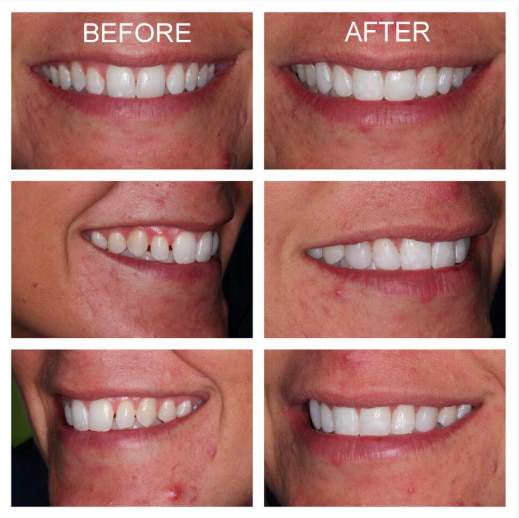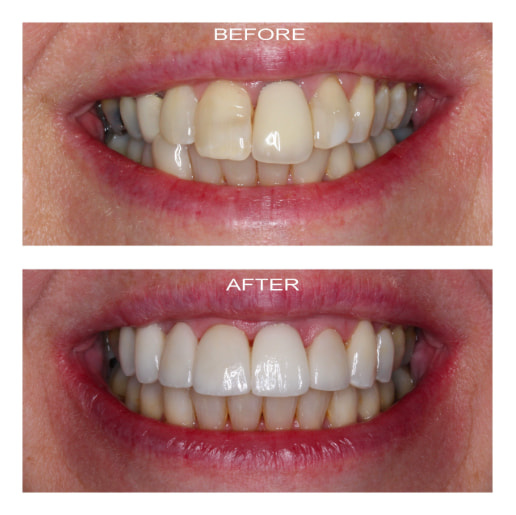
Composite Veneers
Composite veneers are thin shells that fit over the surface of your existing teeth, to improve the appearance of a smile. Composite veneers are often made from tooth coloured resin, the same type of material that is used for tooth bonding.
The veneers are built directly into your mouth in a single visit to the dentist, giving you an instant, natural look, without any tooth reduction. Composite resin veneers can offer an equal standard of improvement to your smile, the same way porcelain veneers do. They are ideal for cosmetic dentistry patients looking for a smile makeover with a smaller price tag.

What Are Composite Veneers?
Composite veneers are made from resin, which is customised to match the colour of your natural teeth. They are shaped directly onto your teeth and allow us to whiten and reshape your teeth. The procedure has minimal to no tooth preparation, provides a natural look and is reversible.
The procedure can be completed in one visit, and it can take between 45 minutes to a few hours, depending on the number of teeth requiring veneers. A composite veneer is ideal for covering imperfections such as misalignments, discolouration, chipped, stained or cracked teeth.
Composite veneers have a lifespan of two to five years and are less expensive compared to porcelain veneers. A combination of techniques can be used for the best results.
Difference Between Composite Bonding and Composite Veneers
Composite bonding and composite veneers use the same techniques and follow the same procedure, however, they are applied to different areas of the teeth.
Composite bonding is only applied to part of a tooth. It is commonly used to cover stains and rebuild fractured, stained or damaged teeth. Composite bonding can also be used to treat temporary bite changes with minimal invasive techniques. The treatment can be completed in one visit. Dental bonding is affordable and provides instant natural looking results.
Composite dental veneers are applied to the entire surface of the tooth, and can be used to treat a single tooth, a couple of teeth or transform an entire smile. Composite veneers are ideal for treating chipped, crooked, discoloured or cracked teeth. Similar to composite bonding, composite dental veneers can be completed in one session, with minimal invasive techniques.
Suitable Candidates for Composite Veneers
Your dentist can confirm whether you are a suitable candidate for dental veneers. The ideal candidate would have:
- No major dental disease
- Minimal fillings in the front teeth
- Staining and discolouration
- Poor overall colour of teeth
- Worn or chipped teeth
- Misaligned teeth, including crowing, gaps or rotations
Composite Veneers Pros and Cons
Composite veneers are sculpted to the desired shape and length of the tooth and then cured using a high intensity light. The dental veneers can be polished to create a more natural tooth-like appearance.
Pros
- Improve the appearance of the smile
- Cost effective treatment
- The treatment can be completed in the same day
- Minimal tooth preparation is required
- Can enhance aesthetic concerns like misshapen teeth and discolouration
- Damage to composite veneers can easily be repaired
Cons
- Results are not long lasting
- Composite resin tends to stain more easily
- The repaired chips are often visible
Treatment Options
There are two kinds of composite veneers to choose from. Both types are made from the same material, but differ in the application process.
Direct Composite Veneers
Direct composite veneers are made of composite resin and are applied directly onto the teeth. The preparation process is very minimal and the application process is minimally invasive.
Indirect Composite Veneers
For indirect composite veneers, the veneers are custom made “indirectly” outside of the mouth, in a dental clinic.
While the indirect composite veneers are being made, a set of temporary dental veneers will be provided in the meantime. At the following appointment, the indirect composite veneers will be applied onto the teeth using adhesive.
Indirect composite veneers are more resistant to abrasions and fractures, however, they tend to cost more than direct composite veneers.

Orthodontics and Veneers Before and After at Putney Dental Care
Composite Veneers Procedure
The composite veneers procedure starts with a thorough teeth clean to prepare them for the application.
The dentist may remove a thin layer of enamel, to help the material stick to the teeth. In some instances, the teeth do not need to be cut if minor changes to colour and shape are necessary.
Depending on the type of dental veneers, the following process will differ.
Direct veneers
For direct veneers, the dentist will carve the enamel to help with adhesion. Next the adhesive glue will be applied to help the composite resin stick to the teeth. Finally, very thin layers of resin material will be added to the teeth’s surface.
The dentist will quickly harden the layers of resin with a light. In consultation with the dentist, a shade or colour will be selected for the veneers. The composite resin colours can be mixed to make the veneers appear more natural.
Indirect veneers
For indirect veneers, after the teeth have been prepared the dentist will take a mould of the teeth, as indirect veneers are created outside of the mouth. When the indirect veneers are prepared, they will be applied to etched teeth with some adhesive. This bonding agent will stop the veneers from moving.
Afterwards, the composite veneers will be placed onto the teeth. Like the direct veneers, a light will be used to harden the bonding agent and adhere the veneers to the teeth. Finally, the dentist will clean up the edges and polish everything up.
Most patients do not require anaesthesia during the procedure, but if you do, you can resume regular activities after the anaesthesia has worn off.
Composite Veneers Cost
The cost of composite veneers is calculated per tooth and varies depending on the individual’s desired results. Factors such as how complex the procedure will be, how many teeth require composite veneers and whether they are direct composite veneers or indirect composite veneers, all influence the cost of composite veneers.
Composite vs Porcelain Veneers
Composite veneers aren’t the only veneer material available, porcelain veneers are another popular option. Porcelain veneers are a thin shell that is customised to fit on the tooth. Composite and porcelain veneers are ideal for enhancing the smile, but depending on budget, amount of enamel damage and purpose, one kind may be more suitable than the other.
Porcelain veneers last longer than composite veneers, are stain resistant and provide a more aesthetic outcome, however they are more expensive than composite veneers.
Composite veneers are a great affordable option with minimal tooth preparation and can enhance discoloured or misshapen teeth.
A consultation with your dentist can help determine which type of veneer is better suited for your aesthetic needs.
Expert Cosmetic Dentistry with Putney Dental
Contact our team at Putney Dental today for more information on our composite and porcelain veneers cost and other cosmetic dentistry procedures. We can help create a personalised recommendation on what type of veneers will work best for you and your aesthetic outcome. We can answer any questions you may have and help you restore your smile.
To book an appointment at our dental clinics, call our experienced and friendly dentists on (02) 98082588. Alternatively, you could fill out our contact form and we will get back to you as soon as we can.
Our cosmetic dentistry team are located near the following locations in Sydney – Gladesville, West Ryde, Meadowbank and Ryde.
FAQs
Can You Remove Composite Veneers?
Yes, composite veneers can be removed.
Composite veneers are easier to remove compared to porcelain veneers, as they often need to be replaced over time due to wear and tear, chipping and discolouration.
How Long Do Composite Veneers Last?
Composite veneers are quite durable and can last from two to five years. After this, the veneers will need to be replaced.
By taking good care of your veneers, you may be able to extend their life.
Using nonabrasive toothpaste, refraining from chewing on ice and other hard objects with your front teeth, and minimising tea and coffee consumption, can help extend the life of your veneers.
Can You Whiten Composite Veneers?
It is not recommended to use traditional whitening treatments on veneers, as they cannot change the colour of the veneers. They can change the colour of your natural teeth, which may result in an uneven toned smile.
Even though you cannot whiten composite veneers, it doesn’t mean you cannot improve the way they look. Professional whitening services can help remove stains from the surface of your teeth. Consult with your dentist for a professional cleaning schedule, tailored to your needs. If your veneers are severely discoloured, your dentist may suggest replacing them.
Cosmetic Dentist Near Me
Address
A. Suite 5, 227 Morrison Rd, Putney, NSW 2112
(Next Door To Royal Rehab)
Reserved Parking Available At Rear.
Opening Hours
Monday – 8:30 am – 5:30 pm
Tuesday – 8:30 am – 5:30 pm
Wednesday – 8:30 am – 5:30 pm
Thursday – 8:30 am – 5:30 pm
Friday – 8:30 am – 5:30 pm
Saturday – 8:00 am – 1:00 pm
Emergency Appointments Available
Call us today on (02) 9808 2588 or book an appointment online.
Book Online